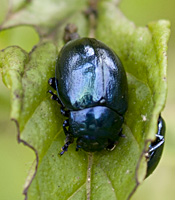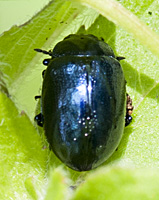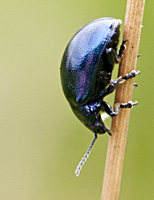[All pictures of garden wildlife on this page are thumbnails. Click on any thumbnail for a large format to be displayed.]

Chrysolina varians (Chrysolina varians)
| Taxonomy | ||||||
|---|---|---|---|---|---|---|
| Kingdom: | Phylum: | Class: | Order: | Family: | Genus: | Species: |
| Animalia | Arthropoda | Insecta | Coleoptera | Chrysomelidae | Chrysolina | C.varians |
The beetles are variable, usually metallic bronze, brown or greenish coloured with finely punctate elytra. Size 4.6 to 6 mm. Adults emerge in early-June and begin feeding in clusters on or under young leaves or on flower buds. They continue to feed until July and early-August. Reproduction is related to day length: with longer daylight, less feeding and reproduction occurs. Mating and egg laying takes place in fall. Females oviposit eggs individually or in small clusters on leaves. Orange coloured eggs are elongated, 1.2mm long and hatch the following spring. The eggs incubate for 6 to 7 days.
Its host plant is St John’s-wort (Hypericum hirsutum).
The plump, humped-back larvae, initially orange coloured, change to dirty pink-grey as they mature. The eggs that have overwintered usually hatch in May. The new larvae feed on buds and immature leaves causing complete defoliation before moving on to adjacent plants.
Chrysolina varians’ habitat appears narrower than other Chrysolina species and as has preference for areas of moist climate. Its native distribution is in Europe from Spain to Asia as far as West Siberia. C. varians occurs in northern and alpine areas of Europe and is common where summers are moist. Widespread and fairly frequent in Britain.

© Copyright 1998-2024 gardensafari.net (Hania Berdys)

 English / engels
English / engels  Dutch / nederlands
Dutch / nederlands


